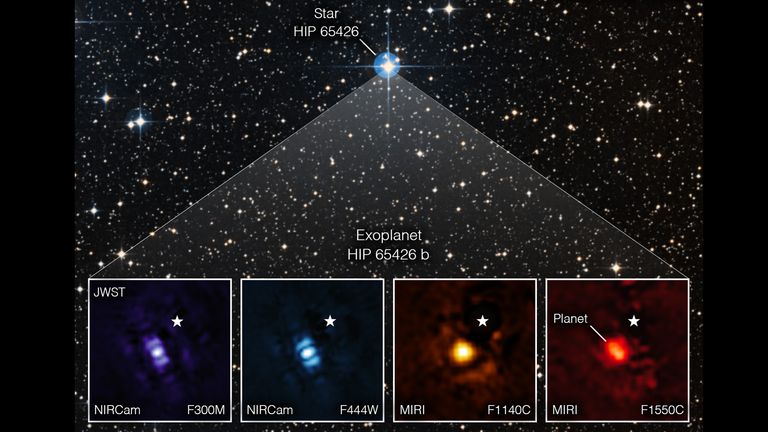NASA’s James Webb Space Telescope has taken its first image of a planet outside our solar system.
The telescope recorded four different views of the planet HIP 65426 b, a gas giant six to 12 times the mass of Jupiter.
“This is a time of transformation, not only for Webb but for astronomy in general,” said Sasha Hinkley, associate professor of physics and astronomy at the University of Exeter.
Astronomers discovered HIP 65426 b in 2017 using the Southern Observatory’s Very Large Telescope in Chile.
But Webb’s images reveal new details that ground-based telescopes would not be able to detect due to the inherent infrared glow of Earth’s atmosphere.
It is a young exoplanet about 15-20 million years old – the Earth is 4.5 billion years old.
Taking direct images of exoplanets presents a challenge because the stars are much brighter than the surrounding planets: HIP 65426 b is over 10,000 times fainter than its host star in the near infrared and a few thousand times fainter in the mid infrared.
Webb has a near-infrared camera (NIRCam) and a mid-infrared (MIRI) instrument, both of which are equipped with coronographs, sets of tiny masks that block starlight.
‘It was really impressive how Webb coronographs worked to suppress the light from the host star,’ said Professor Hinkley.
Since the planet is about 100 times farther from its host star than the Earth is from the Sun, the telescope can easily separate it from the star in the image.
“Getting this image was like looking for space treasure,” said Aarynn Carter, a postdoctoral researcher at the University of California, who conducted the image analysis.
“At first all I could see was the light from the star, but with careful image processing I was able to remove that light and discover the planet.”
Although this is not the first direct image of an exoplanet taken from space, as the Hubble Space Telescope previously captured direct images of exoplanets, the image points the way for future observations that will reveal more information about exoplanets.
“I think the most exciting thing is we’re just getting started,” Carter said.
“There are many more images of exoplanets on the way that will shape our general understanding of their physics, chemistry and formation. We may even discover previously unknown planets.”
Last month the telescope revealed astounding details of the Chariot Wheel Galaxy, and has previously observed a dying star and a “cosmic dance”.

